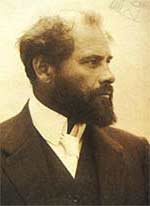 Guest: Mr. Melon, your wife was just showing us her Klimt.
Guest: Mr. Melon, your wife was just showing us her Klimt.
Thornton Melon: You too, huh? She’s shown it to everybody.
Guest: Well, she’s very proud of it.
Melon: I’m proud of mine too. I don’t wave it around at parties.
Guest: It’s an exceptional painting.
Melon: Oh, the painting.
Coinciding with the 150th anniversary of Gustav Klimt’s birthday, we have a report from Austria in which a lost painting by the artist was discovered in a garage.
Trumpeting Putto once adorned the ceiling of Klimt’s Vienna studio where he lived with his brother Ernst in the late 1880s. The painting depicts a cherub in a red scarf blowing his trumpet against the background of a bright blue sky. It disappeared in the 1980s after an elevator was installed in the building.
The discovery was made known by Josef Renz who is noted — in some circles — as an expert on Klimt. Renz purchased the painting from a family in the Linz suburbs. With the initial announcement, Renz claimed the painting was executed by the brothers together if not Gustav alone.
Generally when assertions of authenticity raise eyebrows, skeptics respond with questions rather than pronouncements. “If it’s a Klimt, then why does it blah blah blah …” and that sort of thing. Scholars are often afraid to provide sweeping denunciations for fear of lawsuits. After all, their declarations can cost the owner millions. That type of loss is never appreciated.
Alfred Weidinger doesn’t care about your stinkin’ lawsuit. He is a Klimt specialist and curator of the Schlossmuseum Belvedere in Vienna. Last Sunday, he just stone-cold shot Renz’s claim to shreds. Weidinger told Reuters the work was familiar; he studied it, previously. It was an early, historicist piece by Ernst Klimt who died in 1892. Not only is it a lesser Klimt, but it’s a weak lesser Klimt.
“It’s definitely not an important painting, even for Ernst Klimt,” said Weidinger.
